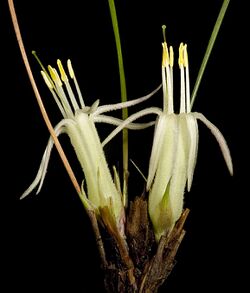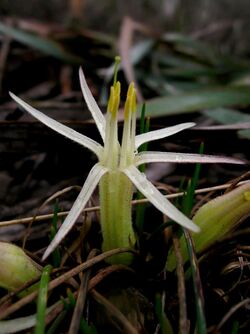Biology:Conostylis androstemma
| Conostylis androstemma | |
|---|---|

| |

| |
| Scientific classification | |
| Kingdom: | Plantae |
| Clade: | Tracheophytes |
| Clade: | Angiosperms |
| Clade: | Monocots |
| Clade: | Commelinids |
| Order: | Commelinales |
| Family: | Haemodoraceae |
| Genus: | Conostylis |
| Species: | C. androstemma
|
| Binomial name | |
| Conostylis androstemma | |

| |
| Occurrence data from AVH | |
| Synonyms[3] | |
|
Androstemma junceum Lindl. | |
Conostylis androstemma (common name trumpets) is a tufted perennial plant species in the family Haemodoraceae. It is endemic to the south-west of Western Australia.[4] Plants grow to between 10 and 30 cm high and produce cream to pale yellow flowers between May and August in the species' native range.[5]
Description
Conostylis androstemma has green, hairless, terete leaves which are 10 to 30 cm long and about 1 mm in diameter. The flower has stems (pedicels) that are less than 1 mm long, and bracts which are about 5 mm long and 2 mm wide.[4] The cream to pale yellow perianth is hairy and radially symmetrical[5] It is 30–50 mm long with a tube which is usually straight. The lobes are not reflexed and are 15 to 25 mm long.[4] There are six stamens, all at the one level.[5] The filaments are 8–17 mm long and the yellow anthers 3–5.5 mm long[4] and without an appendage.[5] The style is 30–50 mm long.[4]
It flowers from May to August.[5]
The plant resprouts from its rhizomes, after fire.[4]
It is easily distinguished from Conostylis argentea by its terete hairless leaves.[4]
Habitat
It grows in lateritic gravel and yellow sand on screes and hilltops,[5]
Distribution
It occurs in south-western Western Australia from Kalbarri National Park to Perth and York.[4]
Taxonomy
Originally named Androstemma junceum and described by John Lindley in 1840 in A Sketch of the Vegetation of the Swan River Colony,[6][7] the species was assigned to the genus Conostylis by botanist Ferdinand von Mueller in 1873 in Fragmenta Phytographiae Australiae and renamed Conostylis androstemma.[1][2]
References
- ↑ 1.0 1.1 "Conostylis androstemma". Australian Plant Name Index (APNI), IBIS database. Centre for Plant Biodiversity Research, Australian Government. https://biodiversity.org.au/nsl/services/rest/name/apni/77287.
- ↑ 2.0 2.1 Mueller, F.J.H. von (1873) Fragmenta Phytographiae Australiae 8(59): 19. Retrieved 8 January 2019.
- ↑ Govaerts, R., et al. (2019) Plants of the world online:Conostylis androstemma. Board of Trustees of the Royal Botanic Gardens, Kew. Retrieved 9 January 2019.
- ↑ 4.0 4.1 4.2 4.3 4.4 4.5 4.6 4.7 "Conostylis androstemma F.Muell.". Flora of Australia Online. Department of the Environment and Heritage, Australian Government. http://www.anbg.gov.au/abrs/online-resources/flora/stddisplay.xsql?pnid=57595.
- ↑ 5.0 5.1 5.2 5.3 5.4 5.5 "Conostylis androstemma". FloraBase. Western Australian Government Department of Parks and Wildlife. https://florabase.dpaw.wa.gov.au/browse/profile/1420.
- ↑ "Androstemma junceum". Australian Plant Name Index (APNI), IBIS database. Centre for Plant Biodiversity Research, Australian Government. https://biodiversity.org.au/nsl/services/rest/name/apni/90560.
- ↑ Lindley, J. (1840) A Sketch of the Vegetation of the Swan River Colony: xlvi.
Wikidata ☰ Q15333169 entry
 |

